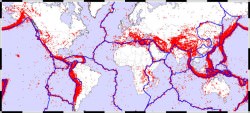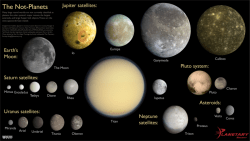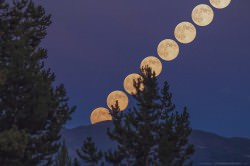The Earth and Moon have been locked in a gravitational dance for billions of years. Each day, as the Earth turns, the Moon tugs upon the oceans of the world, causing the rise and fall of tides. As a result, the Earth’s day gets a little bit longer, and the Moon gets a little more distant. The effect is small, but over geologic time it adds up. About 620 million years ago, a day on Earth was only 22 hours long, and the Moon was at least 10,000 km closer than it is now.
Continue reading “Early Earth's Oceans of Magma Accelerated the Moon's Departure”Did Mars Once Have a Third, Larger Moon?
We are all familiar with our one Moon but other planets have different numbers of moons; Mercury has none, Jupiter has 95 and Mars has two. A new paper proposes that Mars may actually have had a third larger moon. Why? The red planet has a triaxial shape which means it bulges just like Earth does but along a third axis. The paper suggests a massive moon could have distorted Mars into this shape.
Continue reading “Did Mars Once Have a Third, Larger Moon?”Did We Need the Moon for Life?
Astronomers hate the Moon because it ruins perfectly good observing nights. But is it possible that we all need the Moon for our very existence?
For all we know, Earth is the only place in the Universe where life appeared. This makes the mystery of our existence even more puzzling. What were all the factors required to bring about the first lifeforms on our planet, and encourage the evolution of more complex, intelligent lifeforms.
We needed a calm and reasonable Sun, solid ground, nice temperatures, the appropriate chemicals, and liquid water. Possibly drinks served in pineapples with little umbrellas. But what about the Moon? Is the Moon a necessity for life in any way?
To the best of our knowledge, our Moon was formed when a Mars-sized object smashed into the Earth about 4.5 billion years ago. This enormous collision spun out a cloud of debris that coalesced into the Moon we know and love today.
Back then, the Moon was much closer to the Earth than it is today, a mere 20-30,000 kilometers. A fraction of its current distance. If you could have stood on the surface of the Earth, the Moon would have looked 10 to 20 times bigger than we see it today.
But nobody did, because the Earth was a molten ball of red hot magma, tasty lava through and through. Life emerged 3.8 billion years ago, pretty much the day after Earth had cooled down to the point that it was possible for life to form.
Scientists think that it first formed in the oceans, where there were adequate temperatures and abundant water as a solvent for life’s chemicals to mix.
The effect of gravity is a cube of its distance. When the Moon was closer, the power of its gravity to pull the Earth’s water around was more ferocious. But what impact has this gravity had on our world and its life? Do we need the Moon to make the magic happen?
Turns out, we might owe our very existence to it because its pull of gravity might have set our plate tectonics in motion. Without plate tectonics, our planet might be more like Venus, toasty and dead.

It raises the level of the world’s oceans towards the equator. Without this gravity, the oceans would redistribute, raising levels at the poles. It has also slowed Earth’s rotation on its axis. Shortly after its formation, the Earth turned once every 6 hours. Without that Moon to slow us down, we’d have much more severe weather.
It stabilizes the Earth’s rotation on its axis. It’s possible that the Earth might have rolled over on its axis on a regular basis, causing a complete redistribution of the Earth’s water. Astronomers think this happened on Mars, because it never had a large Moon to stabilize it.
But the biggest impact that the Moon has on life is through tides. That regular movement of water that exposes the land at the edge of the ocean, and then covers it again just a few hours later. This could have encouraged life to adapt and move from the oceans to land.
One of the most subtle effects from the Moon is what it has done to life itself. Nocturnal animals behave differently depending on where the Moon is in the sky during its 29.5-day cycle. When the Moon is full and bright, prey fish stay hidden in the reef, when they’d be most visible.

Amazingly, lions are less likely to hunt during the full Moon, and researchers have found that lion attacks on humans happen 10 days after the full Moon, and many bats will be less active during the full Moon.
With so many species on Earth affected by the Moon, it’s reasonable to think that there would have been a different evolutionary direction for life on Earth over the eons, and humans might never have evolved.
It looks like the Moon is important after all. Important to the geology of Earth, and important to the evolution of life itself.
As extrasolar planet hunters search for new worlds, and determine their viability for life, they might want to focus on the worlds with moons first.
What impact has the Moon had on your life? Post your anecdotes in the comments!
What is Tidal Locking?
The Moon is tidally locked to the Earth, which means that it always shows one face to our planet. In fact, this is the case for most the large moons in the Solar System. What’s the process going on to make this happen?
Just look at the Moon, isn’t it beautiful? Take out a nice pair of binoculars, or a small telescope tonight and you’ll be able to see huge craters and ancient lava plains. Look again tomorrow, and you’ll be able to see… the exact same things. As you know, our modest Moon only shows us one face. Ever.
If you could look at the Moon orbiting the Earth from above, you’d see that it orbits once on its axis exactly as long as it takes to orbit once around our planet. It’s always turning, showing us exactly the same face. What’s it hiding?
The Moon isn’t the only place in the Solar System where this happens. All major moons of Jupiter and Saturn show the same face to their parent. Pluto and Charon are even stranger, the two worlds are locked, facing one another for all eternity. Astronomers call this tidal locking, and happens because of the gravitational interaction between worlds.
As you’re aware, the Moon is pulling at the Earth, causing the tides. In fact, the pull of the Moon is so strong that the ground itself rises up 30 cm, about a foot, as it passes by.
It’s even more powerful on the Moon. The gravity from the Earth distorts the Moon into an oblong shape. The sides pointed towards and away from the Earth bulge outward, while the others are pulled inward to compensate. It makes the Moon football shaped.
It’s no big deal now, but in the ancient past, shortly after its formation, the Moon was spinning rapidly. This meant that the part of the Moon bulged towards us was changing constantly, like water tides on Earth.
Vast amounts of rock need to shift and change shape to bulge towards the Earth and then settle down again, and this takes time. The position of the bulges on the Moon were always a little out of alignment with the pull of gravity of the Earth.
These bulges acted like handles that the Earth’s gravity could grab onto, and torque it back into place. Over time, the Earth’s gravity slowed down the rotation speed of the Moon until it stopped, forever.

This same process happened on all the large moons in the Solar System.
Because of its smaller mass, our Moon became tidally locked to the Earth billions of years ago. Now the process is continuing to make the Earth tidally locked to the Moon as well.
In the distant distant future, the Moon will stop moving in the sky, and hang motionless, visible from only half the Earth.
How distant? In about 50 billion years, long after the Sun has died, the Earth and the Moon will finally be tidally locked to each other, just like Romeo and Juliet, Fry and Leela, Pluto and Charon. The force of gravity is a powerful thing. Powerful enough to stop a moon in its tracks.
Did you have any other questions about the Moon? Post your suggestions in the comments and we’d be glad to make more videos and dig deeper!
How Do The Tides Work?
Anyone who lives close to ocean is familiar with the tides. And you probably know they have something to do with the Moon. But how do the tides work? Do other planets experience tides?
Just what the heck are tides? Some kind of orbit jiggle jello effect from the magic Etruscan space-whale song? Is it an unending slap-back of gravitometric Malthusian resonance originating from the core of the Sun’s crystalline liver-light organelles? Is it all the plankton agreeing to paddle in the same direction at their monthly oceanic conferences?
As certain as I am that you enjoy my word terminology salads, with apologies to Papa Bear, we both know tides are caused by the gravitational interaction with the Moon. You would think we’d have only one high tide and one low tide, with the Moon pulling the Earth’s water towards it. Moon goes one side, water rushes over to that side, moon goes to other side, water chases around to follow it. But the tides make the water levels appear to rise twice a day, and lower twice a day in 6 hour increments. So, it’s clearly more complicated than that.
The gravity from the Moon does pull the water towards it. That’s what gives you the highest tide of the day. It’s a bulge of water that follows the Moon around and around as the Earth rotates. This makes sense to us. But then Earth itself is pulled with a little less gravity than the water towards the Moon and, the water on the opposite side of the Earth is pulled with even less gravity, and so you wind up with another bulge on the opposite side of the Earth.
So from our perspective, you end up with a bulge of water towards the Moon, and a bulge away from it. The part of the Earth with the water getting pulled towards the Moon experiences a high tide, and same with the part on the opposite side of the Earth with the other bulge. Correspondingly, the parts of the Earth at right angles are experiencing low tides.
It would be hard enough to predict with a simple spherical Earth covered entirely by water, but we’ve got continents and coastlines, and that makes things even more complicated. The levels that the tides rise and fall depend quite a bit on how easily the water can move around in a region. That’s why you can get such big tides in places like the Bay of Fundy in Canada.

Our Sun also contributes to the tides. Surprisingly, it accounts for about 30% of the them. So when the Sun and the Moon are lined up in the sky, you get the highest high tides and the lowest low tides – these are Spring Tides. And then when the Sun and Moon are at right angles, you get the lowest high tides and the highest low tides. These are Neap Tides.
Tidal forces can be very powerful. They can tear galaxies apart and cause moons to get shredded into pieces. Perhaps the most dramatic example is how Jupiter’s enormous gravity pulls on Io so strongly that its surface rises and falls by 100 meters. This is 5 times greater than the Earth’s biggest water tides. This constant rise and fall heats up the moon, giving it non-stop volcanism.
What do you think? Share your favorite tidal science fact in the comments below. And if you like what you see, come check out our Patreon page and find out how you can get these videos early while helping us bring you more great content!
Why is the Moon Leaving Us?
Goodbye Moon. Every year, the Moon slips a few centimeters away from us, slowing down our day. Why is the Moon drifting away from us, and how long will it take before the Earth and the Moon are tidally locked to each other?
We had a good run, us and the Moon. Grab your special edition NASA space tissues because today we’re embarking on a tale of orbital companionship, childhood sweethearts and heartache.
You could say we came from the same part of town. A long time ago the Mars-sized object Theia, collided with the Earth and the Moon was formed out of the debris from the collision.
We grew up together. Counting from the very beginning, this relationship has lasted for 4.5 billion years. We had some good times. Some bad times. Gravitationally linked, arm in arm, inside our solar family sedan traversing the galaxy.
But now, tragedy. The Moon, OUR Moon, is moving on to brighter horizons. We used to be much closer when we were younger and time seemed to fly by much faster. In fact, 620 million years ago, a day was only 21 hours long. Now they’ve dragged out to 24 hours and they’re just getting longer, and the Moon is already at a average distance of 384,400 km. It almost feels too far away.
If we think back far enough to when we were kids, there was a time when a day was just 2 – 3 hours long, and the Moon was much closer. It seemed like we did everything together back then. But just like people, massive hunks of rock and materials flying through space change, and their relationships change as well.
Our therapist told us it wasn’t a good idea to get caught up on minutiae, but we’ve done some sciencing using the retroreflector experiments placed by Apollo astronauts, and it looks as though the Moon has always had one foot out the door.
Today it’s drifting away at 1-2 cm/year. Such heartache! We just thought it seemed like the days were longer, but it’s not just an emotional effect of seeing our longtime friend leaving us, there’s a real physical change happening. Our days are getting 1/500th of a second longer every century.
I can’t help but blame myself. If only we knew why. Did the Moon find someone new? Someone more attractive? Was it that trollop Venus, the hottest planet in the whole solar system? It’s really just a natural progression. It’s nature. It’s gravity and tidal forces.
And no, that’s not a metaphor. The Earth and the Moon pull at each other with their gravity. Their shapes get distorted and the pull of this tidal force creates a bulge. The Earth has a bulge facing towards the Moon, and the Moon has a more significant bulge towards the Earth.

These bulges act like handles for gravity, which slows down their rotation. The process allowed the Earth’s gravity to slow the Moon to a stop billions of years ago. The Moon is still working on the Earth to change its ways, but it’ll be a long time before we become tidally locked to the Moon.
This slowing rotation means energy is lost by the Earth. This energy is transferred to the Moon which is speeding up, and as we’ve talked about in previous episodes the faster something orbits, the further and further it’s becomes from the object it’s orbiting.
Will it ever end? We’re so attached, it seems like it’ll take forever to figure out who’s stuff belongs to who and who gets the dog. Fear not, there is an end in sight. 50 billion years from now, 45 billion years after the Sun has grown weary of our shenanigans and become a red giant, when the days have slowed to be 45 hours long, the Moon will consider itself all moved into its brand new apartment ready to start its new life.
What about the neighbors down the street? How are the other orbital relationships faring. I know there’s a lot of poly-moon-amory taking place out there in the Solar System. We’re not the only ones with Moons tidally locked. There’s Phobos and Deimos to Mars, many of the moons of Jupiter and Saturn are, and Pluto and Charon are even tidally locked to each other, forever. Now’s that’s real commitment. So, in the end. The lesson here is people and planets change. The Moon just needs its space, but it still wants to be friends.
What do you think? If you were writing a space opera about the Earth and the Moon break-up, what was it that finally came between them? Tell us in the comments below.






